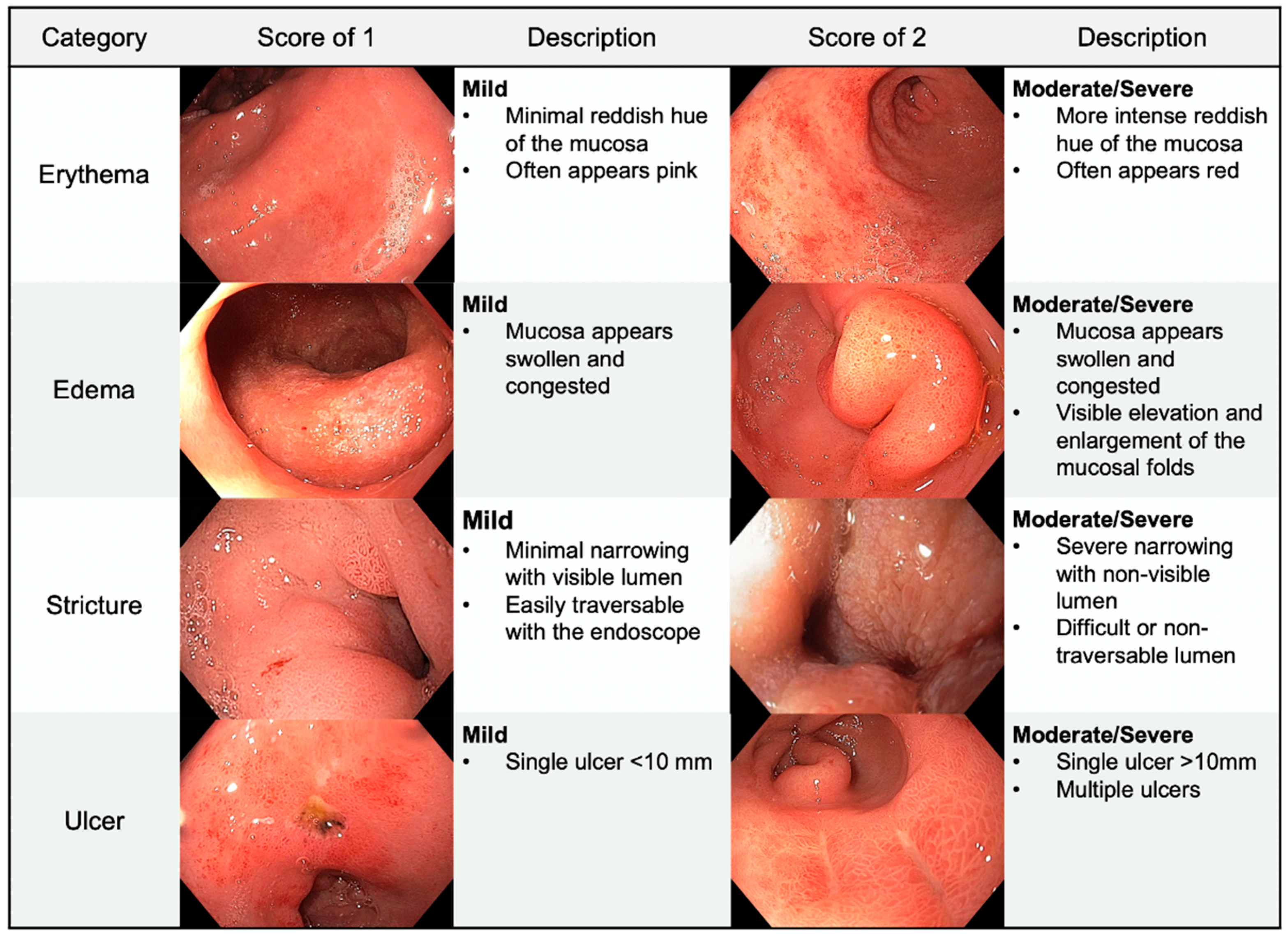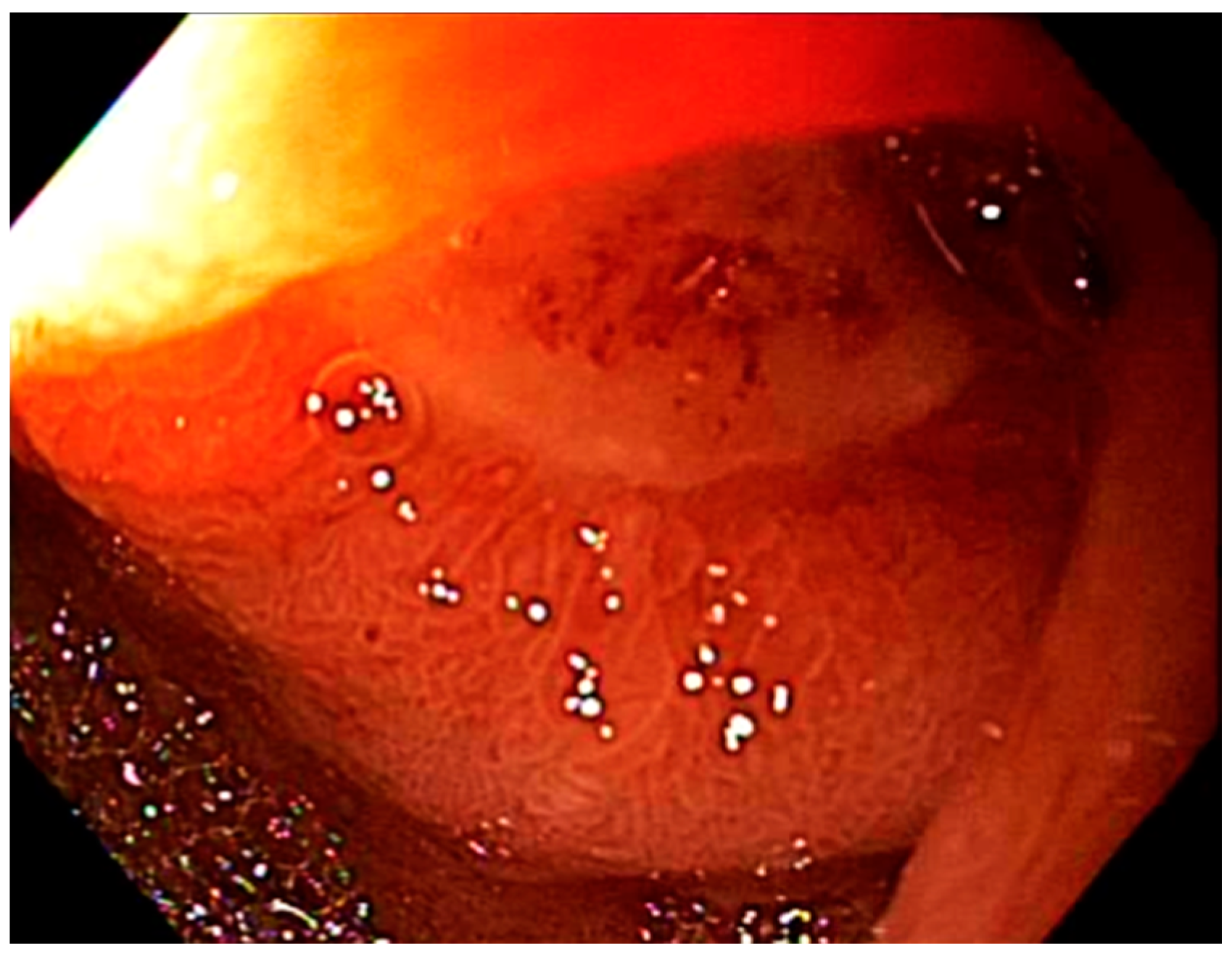Development of an Objective Scoring System for Endoscopic Assessment of Radiation-Induced Upper Gastrointestinal Toxicity
Abstract
Simple Summary
Abstract
1. Introduction
2. Results
2.1. Patient Characteristics
2.2. Toxicity Scoring
2.3. Reliability Testing
2.4. Outcomes
3. Discussion
4. Materials and Methods
4.1. Trial Description
4.2. Endoscopy Description/Fiducial Placement
4.3. Toxicity Scoring System
4.4. Statistical Methods
4.5. Inter-Rater Reliability Testing and Validation
5. Conclusions
Author Contributions
Funding
Institutional Review Board Statement
Informed Consent Statement
Data Availability Statement
Conflicts of Interest
Appendix A
| Characteristic | Score (Circle One) | Points | Notes |
| Erythema | 0 = none 1 = mild (pink) 2 = moderate/severe (red) | ||
| Edema | 0 = none 1 = mild 2 = moderate/severe | ||
| Ulcers * | 0 = none 1 = single 2 = 2 or more ulcers | ||
| Stricture | 0 = none 1 = mild 2 = moderate/severe | ||
| Total Score: | Total Score: 0 = None 1–2 = Mild toxicity 3–4 = Moderate toxicity ≥5 = Severe toxicity | ||
| Toxicity: |
| Characteristic (Circle) | Clean Base | Actively Bleeding | Stigmata of Recent Bleeding |
| Number of Ulcers: |
References
- Siegel, R.L.; Miller, K.D.; Jemal, A. Cancer statistics, 2019. CA Cancer J. Clin. 2019, 69, 7–34. [Google Scholar] [CrossRef] [PubMed]
- Iacobuzio-Donahue, C.A.; Fu, B.; Yachida, S.; Luo, M.; Abe, H.; Henderson, C.M.; Vilardell, F.; Wang, Z.; Keller, J.W.; Banerjee, P.; et al. DPC4 gene status of the primary carcinoma correlates with patterns of failure in patients with pancreatic cancer. J. Clin. Oncol. 2009, 27, 1806–1813. [Google Scholar] [CrossRef] [PubMed]
- Tempero, M.A.; Malafa, M.P.; Al-Hawary, M.; Asbun, H.; Bain, A.; Behrman, S.W.; Benson, A.B.; Binder, E.; Cardin, D.B.; Cha, C.; et al. Pancreatic Adenocarcinoma, Version 2.2017, NCCN Clinical Practice Guidelines in Oncology. J. Natl. Compr. Cancer Netw. 2017, 15, 1028–1061. [Google Scholar] [CrossRef] [PubMed]
- Sia, J.; Glance, S.; Chandran, S.; Vaughan, R.; Hamilton, C. The use of fiducial markers in image-guided radiotherapy for gastric cancer: Gastric cancer fiducial IGRT. J. Med. Imaging Radiat. Oncol. 2013, 57, 626–628. [Google Scholar] [CrossRef] [PubMed]
- Coronel, E.; Cazacu, I.M.; Sakuraba, A.; Luzuriaga Chavez, A.A.; Uberoi, A.; Geng, Y.; Tomizawa, Y.; Saftoiu, A.; Shin, E.J.; Taniguchi, C.M.; et al. EUS-guided fiducial placement for GI malignancies: A systematic review and meta-analysis. Gastrointest. Endosc. 2019, 89, 659–670.e18. [Google Scholar] [CrossRef] [PubMed]
- Colbert, L.E.; Rebueno, N.; Moningi, S.; Beddar, S.; Sawakuchi, G.O.; Herman, J.M.; Koong, A.C.; Das, P.; Holliday, E.B.; Koay, E.J.; et al. Dose escalation for locally advanced pancreatic cancer: How high can we go? Adv. Radiat. Oncol. 2018, 3, 693–700. [Google Scholar] [CrossRef]
- Murphy, J.D.; Christman-Skieller, C.; Kim, J.; Dieterich, S.; Chang, D.T.; Koong, A.C. A Dosimetric Model of Duodenal Toxicity After Stereotactic Body Radiotherapy for Pancreatic Cancer. Int. J. Radiat. Oncol. Biol. Phys. 2010, 78, 1420–1426. [Google Scholar] [CrossRef]
- Colbert, L.E.; Moningi, S.; Chadha, A.; Amer, A.; Lee, Y.; Wolff, R.A.; Varadhachary, G.; Fleming, J.; Katz, M.; Das, P.; et al. Dose escalation with an IMRT technique in 15 to 28 fractions is better tolerated than standard doses of 3DCRT for LAPC. Adv. Radiat. Oncol. 2017, 2, 403–415. [Google Scholar] [CrossRef]
- Zhang, S.; Liang, F.; Tannock, I. Use and misuse of common terminology criteria for adverse events in cancer clinical trials. BMC Cancer 2016, 16, 392. [Google Scholar] [CrossRef]
- Edgerly, M.; Fojo, T. Is There Room for Improvement in Adverse Event Reporting in the Era of Targeted Therapies? J. Natl. Cancer Inst. 2008, 100, 240–242. [Google Scholar] [CrossRef] [PubMed]
- Roydhouse, J.K.; Fiero, M.H.; Kluetz, P.G. Investigating Potential Bias in Patient-Reported Outcomes in Open-label Cancer Trials. JAMA Oncol. 2019, 5, 457–458. [Google Scholar] [CrossRef]
- Zhang, S.; Chen, Q.; Wang, Q. The use of and adherence to CTCAE v3.0 in cancer clinical trial publications. Oncotarget 2016, 7, 65577–65588. [Google Scholar] [CrossRef]
- Fung, C.H.; Hays, R.D. Prospects and challenges in using patient-reported outcomes in clinical practice. Qual. Life Res. 2008, 17, 1297–1302. [Google Scholar] [CrossRef]
- Fleischmann, M.; Vaughan, B. The challenges and opportunities of using patient reported outcome measures (PROMs) in clinical practice. Int. J. Osteopath. Med. 2018, 28, 56–61. [Google Scholar] [CrossRef]
- Moningi, S.; Dholakia, A.S.; Raman, S.P.; Blackford, A.; Cameron, J.L.; Le, D.T.; De Jesus-Acosta, A.M.C.; Hacker-Prietz, A.; Rosati, L.M.; Assadi, R.K.; et al. The Role of Stereotactic Body Radiation Therapy for Pancreatic Cancer: A Single-Institution Experience. Ann. Surg. Oncol. 2015, 22, 2352–2358. [Google Scholar] [CrossRef] [PubMed]
- Herman, J.M.; Chang, D.T.; Goodman, K.A.; Dholakia, A.S.; Raman, S.P.; Hacker-Prietz, A.; Iacobuzio-Donahue, C.A.; Griffith, M.E.; Pawlik, T.M.; Pai, J.S.; et al. Phase 2 multi-institutional trial evaluating gemcitabine and stereotactic body radiotherapy for patients with locally advanced unresectable pancreatic adenocarcinoma: SBRT for Unresectable Pancreatic Cancer. Cancer 2015, 121, 1128–1137. [Google Scholar] [CrossRef]
- Okunieff, P.; Petersen, A.L.; Philip, A.; Milano, M.T.; Katz, A.W.; Boros, L.; Schell, M.C. Stereotactic Body Radiation Therapy (SBRT) for lung metastases. Acta Oncol. 2006, 45, 808–817. [Google Scholar] [CrossRef]
- Moningi, S.; Marciscano, A.E.; Rosati, L.M.; Ng, S.K.; Teboh Forbang, R.; Jackson, J.; Chang, D.T.; Koong, A.C.; Herman, J.M. Stereotactic body radiation therapy in pancreatic cancer: The new frontier. Expert Rev. Anticancer Ther. 2014, 14, 1461–1475. [Google Scholar] [CrossRef] [PubMed]
- Rosati, L.M.; Kumar, R.; Herman, J.M. Integration of Stereotactic Body Radiation Therapy into the Multidisciplinary Management of Pancreatic Cancer. Semin. Radiat. Oncol. 2017, 27, 256–267. [Google Scholar] [CrossRef] [PubMed]
- Zaorsky, N.G.; Lehrer, E.J.; Handorf, E.; Meyer, J.E. Dose Escalation in Stereotactic Body Radiation Therapy for Pancreatic Cancer: A Meta-Analysis. Am. J. Clin. Oncol. 2019, 42, 46–55. [Google Scholar] [CrossRef]
- Thomas, T.O.; Hasan, S.; Small, W.; Herman, J.M.; Lock, M.; Kim, E.Y.; Mayr, N.A.; Teh, B.S.; Lo, S.S. The tolerance of gastrointestinal organs to stereotactic body radiation therapy: What do we know so far? J. Gastrointest. Oncol. 2014, 5, 236–246. [Google Scholar] [CrossRef] [PubMed]
- Thall, P.F.; Cook, J.D. Dose-Finding Based on Efficacy–Toxicity Trade-Offs. Biometrics 2004, 60, 684–693. [Google Scholar] [CrossRef] [PubMed]



| Characteristic | Patients |
|---|---|
| Age (n = 19) | |
| Mean ± SD | 68.6 ± 11.2 |
| Median (IQR) | 71 (64–76) |
| Sex—no. (%) | |
| Male | 9 (47.4) |
| Female | 10 (52.6) |
| Baseline ECOG—no. (%) | |
| 0 | 8 (42.1) |
| 1 | 11 (57.9) |
| T stage—no. (%) | |
| T4 | 19 (100) |
| N stage—no. (%) | |
| Nx | 2 (10.5) |
| N0 | 14 (73.7) |
| N1 | 3 (15.8) |
| M stage—no. (%) | |
| M0 | 19 (100) |
| SBRT dosage—no. (%) | |
| 50 Gy | 12 (63.2) |
| 55 Gy | 7 (36.8) |
| Chemotherapy—no. (%) * | |
| Gemcitabine and abraxane | 11 (57.9) |
| Folfirinox | 13 (68.4) |
| Tumor location—no. (%) | |
| Head | 8 (42.1) |
| Body | 9 (47.4) |
| Tail | 2 (10.5) |
| Baseline CA 19-9 (n = 18) | |
| Mean ± SD | 178.2 ± 513.9 |
| Median (IQR) | 29.6 (8–60.4) |
| Characteristic | None (0) No. (%) | Mild (1–2) No. (%) | Moderate (3–4) No. (%) | Severe (≥5) No. (%) |
|---|---|---|---|---|
| Duodenal Toxicity | ||||
| Pre-treatment (n = 19) | 15 (79) | 4 (21) | 0 (0) | 0 (0) |
| Post-treatment (n = 17) | 5 (29) | 8 (47) | 4 (24) | 0 (0) |
| *Δ Toxicity (n = 17) | 8 (47) | 5 (29) | 4 (24) | 0 (0) |
| Gastric Toxicity | ||||
| Pre-treatment (n = 19) | 10 (53) | 9 (47) | 0 (0) | 0 (0) |
| Post-treatment (n = 17) | 3 (18) | 11 (64) | 3 (18) | 0 (0) |
| *Δ Toxicity (n = 17) | 6 (35) | 10 (59) | 1 (6) | 0 (0) |
| Characteristic (n = 17) | Agreement | Kappa | p-Value | Gwet’s AC1 | p-Value |
|---|---|---|---|---|---|
| Pre-treatment stomach toxicity | |||||
| Erythema | 0.71 | 0.41 | 0.046 | 0.42 | 0.085 |
| Edema | 0.94 | 0.77 | 0.001 | 0.92 | <0.001 |
| Total | 0.71 | 0.49 | 0.003 | 0.59 | 0.002 |
| Pre-treatment duodenum toxicity | |||||
| Erythema | 0.94 | 0.82 | <0.001 | 0.91 | <0.001 |
| Edema | 0.94 | 0 | - | 0.94 | <0.001 |
| Total | 0.88 | 0.65 | 0.001 | 0.86 | <0.001 |
| Post-treatment stomach toxicity | |||||
| Erythema | 0.76 | 0.62 | <0.001 | 0.66 | 0.001 |
| Edema | 0.82 | 0.63 | 0.001 | 0.77 | <0.001 |
| Total | 0.71 | 0.6 | <0.001 | 0.64 | <0.001 |
| Post-treatment duodenum toxicity | |||||
| Erythema | 0.82 | 0.71 | <0.001 | 0.75 | <0.001 |
| Edema | 0.82 | 0.67 | 0.001 | 0.76 | <0.001 |
| Ulcers | 1.00 | 1.00 | <0.001 | 1.00 | - |
| Strictures | 1.00 | 1.00 | <0.001 | 1.00 | - |
| Total | 0.76 | 0.7 | <0.001 |
Publisher’s Note: MDPI stays neutral with regard to jurisdictional claims in published maps and institutional affiliations. |
© 2021 by the authors. Licensee MDPI, Basel, Switzerland. This article is an open access article distributed under the terms and conditions of the Creative Commons Attribution (CC BY) license (https://creativecommons.org/licenses/by/4.0/).
Share and Cite
Lin, D.; Moningi, S.; Abi Jaoude, J.; Singh, B.S.; Cazacu, I.M.; Kouzy, R.; Nogueras Gonzalez, G.M.; Angsuwatcharakon, P.; Herman, J.M.; Bhutani, M.S.; et al. Development of an Objective Scoring System for Endoscopic Assessment of Radiation-Induced Upper Gastrointestinal Toxicity. Cancers 2021, 13, 2136. https://doi.org/10.3390/cancers13092136
Lin D, Moningi S, Abi Jaoude J, Singh BS, Cazacu IM, Kouzy R, Nogueras Gonzalez GM, Angsuwatcharakon P, Herman JM, Bhutani MS, et al. Development of an Objective Scoring System for Endoscopic Assessment of Radiation-Induced Upper Gastrointestinal Toxicity. Cancers. 2021; 13(9):2136. https://doi.org/10.3390/cancers13092136
Chicago/Turabian StyleLin, Daniel, Shalini Moningi, Joseph Abi Jaoude, Ben S. Singh, Irina M. Cazacu, Ramez Kouzy, Graciela M. Nogueras Gonzalez, Phonthep Angsuwatcharakon, Joseph M. Herman, Manoop S. Bhutani, and et al. 2021. "Development of an Objective Scoring System for Endoscopic Assessment of Radiation-Induced Upper Gastrointestinal Toxicity" Cancers 13, no. 9: 2136. https://doi.org/10.3390/cancers13092136
APA StyleLin, D., Moningi, S., Abi Jaoude, J., Singh, B. S., Cazacu, I. M., Kouzy, R., Nogueras Gonzalez, G. M., Angsuwatcharakon, P., Herman, J. M., Bhutani, M. S., & Taniguchi, C. M. (2021). Development of an Objective Scoring System for Endoscopic Assessment of Radiation-Induced Upper Gastrointestinal Toxicity. Cancers, 13(9), 2136. https://doi.org/10.3390/cancers13092136









